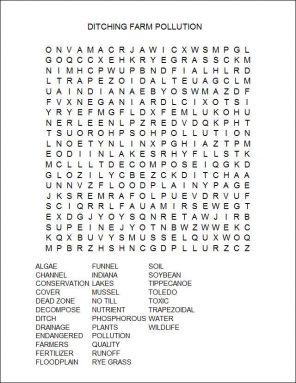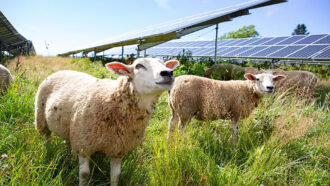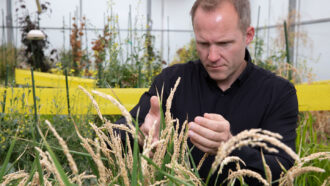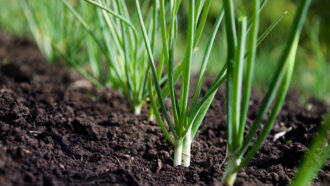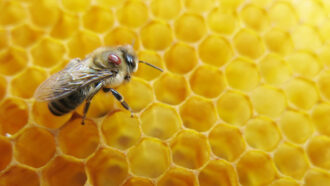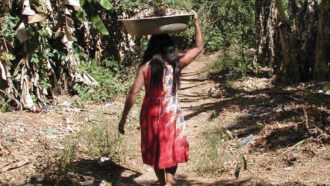Ditching farm pollution — literally
Reducing fertilizer runoff benefits both farmers and the environment
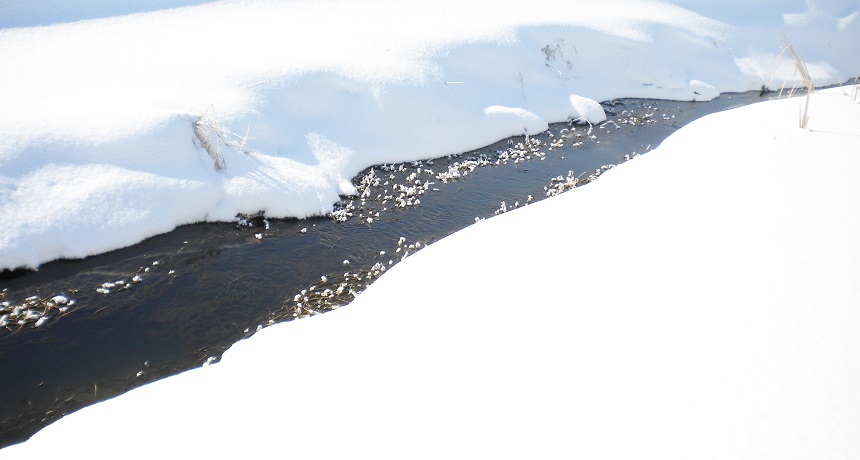
March snowdrifts blanket both levels of Shatto Ditch outside Mentone, Ind. This ditch is a demonstration project to cut the runoff of farm pollution during spring snowmelts and rains.
K. M. Kowalski.
A ditch shrouded in snow may look serene. But soon it will begin funneling potentially toxic pollution from nearby farm fields into nearby lakes and streams. Scientists are now looking to reshape those ditches to keep farm chemicals and soils where they’ll do the most good: on the farm.
Farmers often construct ditches along natural drainage paths. These channels carry away excess rain that might otherwise flood fields. Many ditches also have tile drains. These run under fields to remove rainwater that might waterlog the roots of crops.
Most farm ditches in the American Midwest have a trapezoidal design. Two sides slope down to a flat bottom that is parallel to the field level. As winter snows melt, lots of water will flow off fields and down those ditches. Spring rains will soon follow, carrying away soil and fertilizer applied to croplands. Environmental scientists refer to this water and the stuff it picks up as it flows across and through soils as runoff.
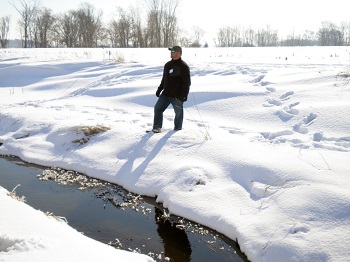
At Shatto Ditch outside Mentone, Ind., Tank is working to show how a two-tiered ditch design and other steps can keep valuable soil and polluting chemicals out of lakes and streams. “A demonstration project is really useful to show that something can work in the ‘real world’ under real-world conditions,” she says. Her partners are farmers and researchers with The Nature Conservancy and the local Soil and Water Conservation District. Their goal: Reduce runoff.
The problem
Fertilizer costs farmers lots of money. But it’s worth it, because it helps their crops grow bigger and faster. Pesticides can keep plants healthy by deterring the growth of weeds or insects and other pests that eat leaves, roots and crops. But once those chemicals leave the farm, they no longer help. They’re simply pollutants. And they can harm species elsewhere.
For example, Shatto Ditch empties into the Tippecanoe River. The endangered clubshell mussel lives there, along with other species. Pollutants in runoff can poison them.
Washed-away fertilizer that was meant for crops can also feed other organisms, including harmful algae and bacteria. If they grow out of control, they can create a harmful “bloom.” Such blooms can kill fish and other water-dwelling creatures. That happens because the numerous algae and bacteria eventually die and decompose. That process sucks up oxygen and creates low-oxygen “dead zones.”
Algal blooms also can produce poisons. Last August, an algal bloom in Lake Erie shut down the public water supply for Toledo, Ohio. City officials found a toxin called microcystin (MY-kroh-SIS-tin) at levels above one part per billion. This toxin can harm a person’s liver and nervous system. And people aren’t the only organisms that can suffer from this. Wildlife will too.
Even the runoff of soil can harm the environment. In the case of American’s biggest amphibians, the hellbenders, that sediment can cloud the rivers that these salamanders call home. In extreme cases, it can suffocate them.
In hopes of heading off these problems, researchers have been working on new approaches to runoff control.
How the two-tier ditch works
The part of Shatto Ditch used for Tank’s demonstration project stretches 0.8 kilometer (0.5 mile). The project rebuilt that stretch as a two-stage ditch. Land on each side slopes down to a middle level almost 2 meters (nearly 6 feet) wide. The ditch sides slope down again to the ditch’s main channel below.
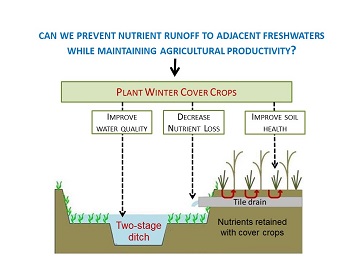
Land at the middle level acts like the floodplains that often build up from silt when streams overflow their banks. Plants and soil microbes at that level help trap soils and catch nutrients, such as phosphorus and nitrate. The design also slows water flow under most conditions.
Tank’s team has done chemical testing on water samples from Shatto Ditch since 2007. Compared to a trapezoidal ditch upstream, the two-stage ditch has clearer water flowing out. That means less soil is flowing away. That water also has lower nutrient levels.
“There are water quality benefits,” stresses Tank. The Shatto Ditch project is short compared to all the ditches and streams in the Midwest. But even small improvements in water quality can add up over thousands of miles in a river system.
That’s not all
The Shatto Ditch project includes other conservation practices as well. Some nearby farmers leave dead plants and stalks on the ground instead of plowing them up each fall. This so-called no-till practice helps prevent erosion of valuable crop soil.
Most farmers around the project also plant winter cover crops, such as annual rye grass. The green tops die off after snow falls and grow again in early spring. But long roots reach down into the soil the whole time. “The roots are holding nutrients on the land and not letting them run off into the water,” Tank says. At planting time, farmers kill the grass or other cover planting. Then they sow corn, soybeans or other crops.
Tank’s team sampled tile drains along Shatto Ditch throughout the year before widespread planting of winter cover crops began in the fall of 2013. They continued sampled drains throughout the following year. Levels of nitrates, one of the chemicals in fertilizer, dropped almost 40 percent. The samples also had lower levels of another fertilizer component, a form of phosphorus.
“These data are preliminary,” Tank notes. Other scientists still need to review the findings. But the results seem promising. Her team plans to publish its research soon.
The benefits
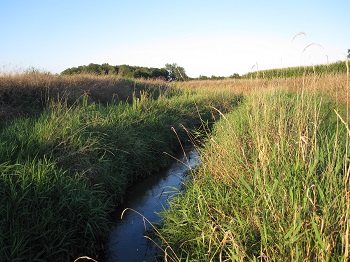
Local Indiana farmers are find value in adopting these practices. Mike Long of Warsaw and Jamie Scott of Pierceton say their farms need less fertilizer since they began taking part in the Shatto Ditch project. They believe that’s because fewer nutrients from soils and previous fertilizer applications wash away. Spending less on fertilizer saves money now.
Over time, ditch maintenance could cost them and other farmers less as well. Silt builds up on the bottom of ditches, so most ditches need to be dug out every few years. With the two-stage ditch design, any soil that washes off fields tends to stay on the middle level. The bottom shouldn’t fill up as quickly.
The project offers environmental benefits too. “Projects like these are a huge step towards controlling heavy phosphorus loads in the face of these heavy rain storms that we seem to be getting in the springtime,” says Justin Chaffin. He’s a limnologist — someone who studies inland waters — at Ohio State University’s Stone Laboratory at Put-in-Bay. Chaffin is not part of the Shatto Ditch project.
“I applaud Tank’s approach to look at multiple practices in combination,” adds Jonathan Witter. He’s an agricultural engineer at Ohio State’s Agricultural Technical Institute in Wooster. Although not working on the Shatto project, he has experience studying other two-stage ditches. Stacking or combining practices, such as the two-stage design and winter cover crops, “is going to be a necessity,” he says. Otherwise, runoff pollution will continue, and the environmental problems it causes could get worse.
A demonstration project like Shatto Ditch can be “a real catalyst for other people adopting this strategy,” Witter stresses. “They can see it. They can watch it.” And by seeing it work they can be encouraged to try it on their own farms, he says.
Indeed, Tank hopes more farmers will start stacking conservation strategies. Reducing fertilizer runoff makes sense for the environment, as well as offering “dollars and cents” benefits to farmers, she says.
Power Words
(for more about Power Words, click here)
algae Single-celled organisms, once considered plants (they aren’t). As aquatic organisms, they grow in water. Like green plants, they depend on sunlight to make their food.
bacterium (plural bacteria) A single-celled organism. These dwell nearly everywhere on Earth, from the bottom of the sea to inside animals.
biology The study of living things. The scientists who study them are known as biologists.
bloom (in microbiology) The rapid and largely uncontrolled growth of a species, such as algae in waterways enriched with nutrients.
ecology A branch of biology that deals with the relations of organisms to one another and to their physical surroundings. A scientist who works in this field is called an ecologist.
erosion The process that removes rock and soil from one spot on Earth’s surface and then deposits the material elsewhere. Erosion can be exceptionally fast or exceedingly slow. Causes of erosion include wind, water (including rainfall and floods), the scouring action of glaciers, and the repeated cycles of freezing and thawing that often occur in some areas of the world.
fertilizer Nitrogen and other plant nutrients added to soil, water or foliage to boost crop growth or to replenish nutrients that removed earlier by plant roots or leaves.
floodplain The nearly flat land that runs along the side of a river, for some distance out from the water. When the river floods, it spills over into this plain, which is built up, over time, with the silt left as the waters recede. That silt tends to be soil that eroded off of the upstream lands during rains.
habitat The area or natural environment in which an animal or plant normally lives, such as a desert, coral reef or freshwater lake. A habitat can be home to thousands of different species.
limnology A branch of ecology that studies inland waters, including lakes, streams and groundwater. A scientist who works in this field is called a limnologist.
microcystins A class of toxins produced by some freshwater algae that are also known as cyanobacteria. Most of these toxins work by poisoning the liver.
nitrate An ion formed by the combination of a nitrogen atom bound to three oxygen atoms. The term is also used as a general name for any of various compounds formed when other atoms combine with that ion group.
no till The somewhat recent practice by some farmers to leave crop residues (stalks, leaves and roots) in place over the winter, instead of turning over the dirt and burying these materials as soil nutrients. The purpose: These plant residues help anchor the soil in place over the fall and winter, reducing soil losses to erosion.
parallel An adjective that describes two things that are side by side and have the same distance between their parts. In the word “all,” the final two letters are parallel lines.
parts per million (or billion, or trillion) Frequently abbreviated as ppm (or ppb or ppt), it is a measure of the number of units of some material that have been mixed into another. The units should be the same (or equivalent) for both materials. So 3 ppb lead in water would be 3 parts of lead in every billion parts of water.
peer review (in science) A process in which scientists in a field carefully read and critique the work of their peers before it is published in a scientific journal. Peer review helps to prevent sloppy science and bad mistakes from being published.
phosphorus A highly reactive, nonmetallic element occurring naturally in phosphates. Its scientific symbol is P.
pollutant A substance that taints something — such as the air, water, our bodies or products. Some pollutants are chemicals, such as pesticides. Others may be radiation, including excess heat or light. Even weeds and other invasive species can be considered a type of biological pollution.
runoff The water that runs off of land into rivers, lakes and the seas. As that water travels over land, it picks up bits of soil and chemicals that it will later deposit as pollutants in the water.
silt Very fine mineral particles or grains present in soil. They can be made of sand or other materials. When materials of this size make up most of the particles in soil, the composite is referred to as clay. Silt is formed by the erosion of rocks, and then usually deposited elsewhere by wind, water or glaciers.
tillage (v. to till) A common practice by farmers of turning over soil on croplands to remove weeds and/or cultivate the land.
toxin A poison produced by living organisms, such as germs, bees, spiders, poison ivy and snakes.
trapezoid A four-sided geometric figure with only one pair of parallel sides.
Word Find (click here to enlarge for printing)
